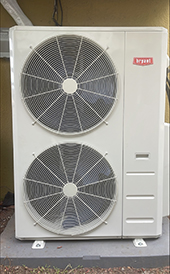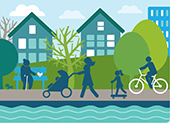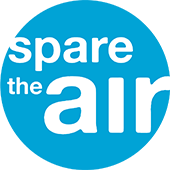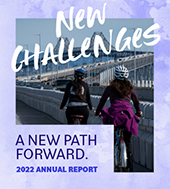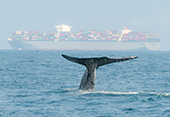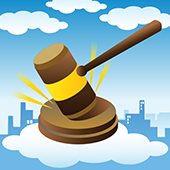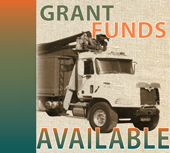|
|

|
|
|
|
May 2023 l Volume 2023-2
|
|
|
|
|
|
|
IIn this issue, you’ll find articles about the Air District’s new Building Appliance Rule amendments, the state’s approval of Bayview Hunters Point/Southeast San Francisco as a new Community Air Protection Program area, the beginning of the summer smog season and publication of the Air District’s Annual Report. Other articles cover the Air District’s support of legislation that would expand the Blue Whales Blue Skies vessel speed reduction program statewide, and a recent agreement with Recology to close a debris-crushing site in Bayview Hunters Point. Current grant opportunities are also summarized.
|
|
|
|
|
|
|
|
|
|
|
|
|
|
Air District Strengthens Building Appliance Rules to Protect Air Quality and Public Health
|
|
| | |
|
In March, the Air District’s Board of Directors adopted amendments to Regulation 9, Rules 4 and 6, to eliminate emissions of nitrogen oxides, or NOx, from residential and commercial natural gas furnaces and water heaters in the Bay Area by requiring new appliances to be zero-NOx. The amount of nitrogen oxide emissions from natural gas building appliances is similar to that caused by passenger vehicles in the Bay Area. As a group, the 1.8 million water heaters and furnaces are one of the largest NOx-emitting stationary sources of air pollution in the region.
The rule amendments would apply only to new appliances sold in the Bay Area. They do not mandate the immediate change-out of existing appliances, nor will they apply to appliances used for cooking, such as gas stoves. NOx-emitting natural gas furnaces and water heaters will be phased out over time, beginning with water heaters in 2027.
The rule amendments will improve overall regional air quality from the outdoor venting of these appliances, lower exposure to particulate matter - particularly in communities of color - and eliminate up to $890 million per year in health impacts due to air pollution exposure.
NOx emissions impact local and regional air quality and contribute to the formation of ozone and particulate matter, or PM2.5. Exposure to NOx has been linked to coughing, wheezing, difficulty breathing, asthma and increased susceptibility to respiratory infections. Exposure to particulate matter has been linked to asthma and other respiratory conditions, neurological disease, heart attacks, stroke, lung cancer and premature death. The new amendments will safeguard public health against the hazards of these pollutants and prevent an estimated 85 premature deaths, as well as dozens of new asthma cases, in the Bay Area each year.
The Air District released a draft environmental impact report and solicited comments to the proposed rule amendments through a 45-day public comment period, which ended on February 6, 2023.
Compliance dates range between 2027 and 2031, dependent on the equipment type, use and size. To learn more about the building appliance rules and compliance timelines, visit the Air District's Rules 9-4 and 9-6 Building Appliances web page.
|
|
|
|
|
|
|
|
|
|
|
|
State Approves Bayview Hunters Point/Southeast San Francisco for AB 617 Funding to Expand Emissions Reduction Work
|
|
| | |
|
In February, the Air District announced that the California Air Resources Board voted to formally include Bayview Hunters Point/Southeast San Francisco in the state’s Community Air Protection Program, established by Assembly Bill 617. This key move directs state funds and resources to a vibrant, historically significant and culturally rich Bay Area community. To combat the disparate pollution burdens that exist in the Bayview Hunters Point neighborhood, the Air District, in co-equal partnership with the Bayview Hunters Point Community Advocates and Marie Harrison Community Foundation, will develop a Community Emissions Reduction Plan, or CERP, that will serve as a blueprint for improving air quality in Bayview Hunters Point/Southeast San Francisco.
After community members nominated their community to the AB 617 program, the Air District, with CARB’s support, selected Bayview Hunters Point/Southeast San Francisco as a high priority community for focused action in the Bay Area due to longstanding air quality challenges, environmental justice issues and health inequities.
Bayview Hunters Point/Southeast San Francisco, located mainly in District 10, will be the fourth AB 617 area in the Bay Area that CARB has supported for a CERP, joining West Oakland, Richmond-North Richmond-San Pablo and East Oakland. The goal of the CERP is to focus and accelerate new actions selected by community members that go beyond existing state and regional programs to provide direct reductions in air pollution emissions and exposures.
The CERP will establish emissions reduction targets, outline reduction strategies and include an implementation schedule and an enforcement plan. The CERP process will be guided by a 25-member community-based steering committee. The Air District encourages Bayview Hunters Point/Southeast San Francisco residents and representatives of the community to apply to be part of this steering committee, which is expected to begin work in June.
For more information, view the Air District’s Bayview Hunters Point/Southeast San Francisco Community Health Protection Plan web page.
|
|
|
|
|
|
|
|
|
|
|
|
Spare the Air Smog Season Begins
|
|
| | |
|
The Air District’s Spare the Air summer smog season begins on Monday, May 1. Millions of cars on our roadways each day remain the largest source of smog pollution and greenhouse gas emissions in the Bay Area. The Spare the Air campaign encourages Bay Area residents to drive less and look for ways to share, shorten or change their commutes to help reduce smog, traffic and gridlock in the region. The Air District has already issued its first Spare the Air Alert of the year on April 27.
The launch of the Spare the Air smog season coincides with the start of the 2023 Air Quality Awareness Week, a nationwide campaign to increase air quality awareness and inspire people to take steps to reduce their contribution to air pollution. This year’s campaign highlights resources that spread awareness of air quality issues and encourages people to take action and incorporate air quality knowledge into their daily lives.
Spare the Air Alerts are issued when smog, or ozone pollution, is forecast to reach unhealthy levels. Ozone can cause throat irritation, congestion and chest pain. It can trigger asthma, inflame the lining of the lungs, and worsen bronchitis and emphysema. Ozone pollution is particularly harmful for young children, seniors, and those with respiratory and heart conditions. When a Spare the Air Alert is called, limit outdoor exercise in the late afternoon when temperatures and ozone concentrations are highest.
To find out when a Spare the Air Alert is in effect, residents can register for email or text notifications at www.sparetheair.org/alerts, call 1(800) HELP-AIR, download the Spare the Air Bay Area App or connect with Spare the Air on Facebook or Twitter.
|
|
|
|
|
|
|
|
|
|
|
|
“New Challenges: A New Path Forward” - 2022 Annual Report Highlights Air District’s Ongoing Work to Expand Community Protections and Climate Solutions
|
|
| | |
|
The Air District’s 2022 annual report highlights our achievements over the past year through a dynamic website featuring original video content and animated graphics. The new challenges posed by our changing climate require a new path forward as we continue to protect and improve air quality and public health for all Bay Area residents. In 2022, the Air District built new partnerships in communities disproportionately impacted by air pollution and expanded our work to provide clean air spaces for those most vulnerable. At the same time, we furthered our innovative climate protection work to accelerate electrification and incentivize greenhouse gas reductions.
Check out our 2022 accomplishments. (The 2022 Annual Report will be available starting Tuesday, May 2.)
|
|
|
|
|
|
|
|
|
|
|
|
Air District Urges Passage of AB 953 to Expand Protecting Blue Whales and Blue Skies Program Statewide
|
|
| | |
|
The Air District is sponsoring Assembly Bill 953 (Connolly and Hart), a piece of legislation that would expand the voluntary vessel speed reduction program, Protecting Blue Whales and Blue Skies, throughout the state. Expansion of this program to cover the entire California coast would reduce air pollution and greenhouse gases and decrease the risk of fatal vessel strikes on whales. Protecting Blue Whales and Blue Skies currently covers the San Francisco Bay and Southern California coastal regions and incentivizes companies to incorporate sustainable shipping practices across their global supply chain. By designating slow-speed zones where oceangoing container vessels and other ships voluntarily travel at a rate of 10 knots or less, the program helps improve air quality and human health outcomes while protecting endangered whales.
The Bay Area Air District, along with the Santa Barbara County and Ventura County air districts, are part of a unique partnership of federal and local government agencies, foundations and environmental nonprofits that have administered the Protecting Blue Whales and Blue Skies since 2014.
From the program’s inception through 2021, it has achieved 526,211 slow speed miles, a reduction of more than 2,300 tons of oxides of nitrogen, a reduction of over 76,000 metric tons of greenhouse gas emissions and an estimated 50 percent decreased risk of fatal whale strikes during prime migration season in the targeted coastal areas.
AB 953 would task the Ocean Protection Council – in coordination with California air districts along the coast and in consultation with the federal Office of National Marine Sanctuaries, the U.S. Environmental Protection Agency, the U.S. Navy, the California Air Resources Board and other stakeholders – to create a statewide voluntary vessel speed reduction and sustainable shipping program for the California coast. The bill would build upon the existing Protecting Blue Whales and Blue Skies program as well as any other existing local vessel speed reduction programs.
|
|
|
|
|
|
|
|
|
|
|
|
Air District Forges Agreement with Recology to Close Operations in Bayview Hunters Point
|
|
| | |
|
In March, the Air District announced that it successfully secured a Termination and Closure Agreement with Recology San Francisco, terminating operations at its Bayview Hunters Point inert-debris-crushing site. This action will require Recology to fully vacate the site by the end of the year and comply with additional dust control provisions. This agreement also resolves an outstanding Notice of Violation for missing a permit deadline.
Recology had operated a facility at Pier 94, Lot 352 in San Francisco, that crushed inert debris, such as construction and demolition materials, for the purpose of rendering those materials suitable for recycling and reuse.
This agreement sets the terms of the closure, resolves the NOV and requires the company to comply with dust control measures that are even more stringent than those required by Air District regulations. The agreement also stipulates quickly escalating penalties if Recology does not vacate the site by December 31, 2023.
The dust control measures to be enforced while all materials are transported off-site include watering of debris piles, immediate coverage by tarp of end-dump trailers when filled, a traffic speed limitation of five miles per hour on site, limited on-site travel lanes, and stabilizing of inbound and outbound roadways to allow for cleaning truck tires and to prevent fugitive dust emissions from wheels.
A metal rumble rack will be utilized to shake dust off truck tires and prevent track out, and a water truck will keep driving surfaces moist. A sweeper truck will also be employed for several hours a day, Monday through Friday, along the main travel corridors.
The Air District will enforce strict limits on visible dust emissions and will require additional measures to be implemented should the facility incur public nuisance violations during the debris removal process.
The Air District issues Notices of Violation when facilities violate a specific air quality regulation or rule. Violators are generally required to respond to the notice within 10 days and submit a description of the actions they will take to correct the problem. These actions can include shutting down certain operations immediately or changing operations or equipment to come into compliance.
|
|
|
|
|
|
|
|
|
|
|
|
Air District Offers Millions in Grants
|
|
| | |
|
The Air District administers a number of grant funding programs that offer incentives for clean air projects. Grant Funding for Clean Air Projects
Grant programs for Bay Area businesses and public agencies:
- Grants for Heavy-Duty Equipment* are available for eligible projects that reduce toxic air emissions and ozone-forming pollutants through the scrap and replacement of older, high-polluting vehicles and equipment. Eligible project categories include upgrades or replacements of:
- School buses, transit buses, and shuttles
- Heavy-duty trucks, emergency vehicles, and transportation refrigeration units (TRUs)
- Off-road construction, industrial, and agricultural equipment, for example: dozers, forklifts, tractors, ag pumps, and portable or stationary engines
- Off-road port and freight equipment, including cargo-handling equipment and airport ground support equipment
- Marine vessel engines and locomotives
- Charging and refueling infrastructure projects that support heavy-duty zero-emission vehicles, including battery-electric and hydrogen fuel-cell vehicles, are also eligible
Applications are accepted on a first-come, first-served basis, with a portion of available funding prioritized for projects that operate in or that benefit disadvantaged and low-income areas, and areas that are most highly impacted by air pollution, including the AB 617-identified communities of West Oakland, East Oakland, Richmond-San Pablo, and Bayview Hunters Point/Southeast San Francisco. Apply at www.baaqmd.gov/funding-and-incentives. This program will be closing on June 8, 2023, and is tentatively scheduled to reopen in September 2023.
*Projects are funded by the Carl Moyer Program, Community Air Protection Program, Transportation Fund for Clean Air, Goods Movement, Mobile Source Incentive Fund, and Funding Agricultural Replacement Measures for Emission Reductions (FARMER) program.
- Climate Tech Finance Loan Guarantee Program is available to support the development and purchase of climate technologies for small businesses in California. Climate entrepreneurs can apply for loan guarantees up to 80 percent of the loan principal or $5 million, whichever is less, to accelerate the growth and impact of their businesses. This program is open and accepting applications now. https://ctf.baaqmd.gov/
Grant programs available to Bay Area residents:
- Passenger Car and Light-Duty Truck Retirement – The Vehicle Buy Back Program pays Bay Area residents $1,200 per vehicle to turn in their operable, registered, model year 1998 and older passenger car or light-duty truck for scrapping. www.baaqmd.gov/vbb
- Clean Cars for All Program, Light-Duty Vehicle Replacement – The Clean Cars for All Program is open to income-qualified Bay Area residents in qualifying zip codes. The program provides grants of up to $9,500 to retire older, high-polluting vehicles and replace them with a new or used conventional hybrid, plug-in hybrid, fuel-cell, or electric vehicle. Residents that don’t want to purchase a replacement vehicle can receive $7,500 towards alternative mobility options (e.g. public transit or electric bicycles). www.baaqmd.gov/cleancarsforall
Other state-wide grant programs funded by Volkswagen NOx Mitigation Trust (only the first is administered by the Bay Area Air District):
- VW Zero-Emission Freight and Marine Program – Funding is available statewide to accelerate the replacement of older, higher polluting diesel engines with zero-emission technology. Approximately $25 million in Volkswagen Environmental Mitigation Trust funding is available for projects that do one or more of the following:
- Scrap combustion-based airport ground support equipment and replace with all-electric,
- Scrap combustion-based heavy-lift forklifts (> 8,000 pounds of lift capacity) and replace with all-electric,
- Scrap combustion-based port cargo-handling equipment and replace with all-electric,
- Scrap combustion-based ferry, tugboat, or towboat engines and replace with all-electric, and/or
- Install portside shore power systems at berths for use by unregulated oceangoing vessels.
75 percent of funding will be awarded to projects that reduce emissions in California’s disadvantaged and low-income communities. This solicitation is open and accepting applications on a first-come, first-served basis until all funds are fully allocated. https://www.californiavwtrust.org/zero-freight-marine/
- VW Combustion Freight and Marine Projects – Funding is available statewide to accelerate the replacement of older, higher polluting diesel engines with the cleanest available technologies. Equipment eligible for replacement includes Class 7 and 8 freight trucks (including waste haulers, dump trucks, and concrete mixers) or their engines (2012 model year and older) that are compliant with current regulations; freight switcher locomotives or their engines (pre-Tier 1); and ferry, tugboat, and towboat engines (pre-Tier 3). This solicitation is open and accepting applications on a first-come, first-served basis until all funds are fully allocated. https://xappprod.aqmd.gov/vw/combustion.html
- VW Zero-Emission Class 8 Freight and Port Drayage Trucks - This category is intended to support the expansion of zero-emission truck availability in the heaviest weight class. Vehicles eligible for replacement include Class 8 freight trucks (including drayage trucks, waste haulers, dump trucks, and concrete mixers) or their engines (2012 model year and older). This solicitation is open and accepting applications on a first-come, first-served basis until all funds are fully allocated. https://xappprod.aqmd.gov/vw/zero-emission.html
- VW Zero-Emission Transit and Shuttle Buses – The second installment of VW funding is available to owners of bus fleets that operate in California to support early adoption of zero-emission bus technologies to reduce harmful exposure for the state’s most sensitive populations. This program is administered by the San Joaquin Valley Air Pollution Control District. The zero-emission school bus bin is now oversubscribed. This solicitation is open and accepting applications for transit and shuttle buses on a first-come, first-served basis until all funds are fully allocated. http://vwbusmoney.valleyair.org/
|
|
|
|
|
|
|
|
|
|


